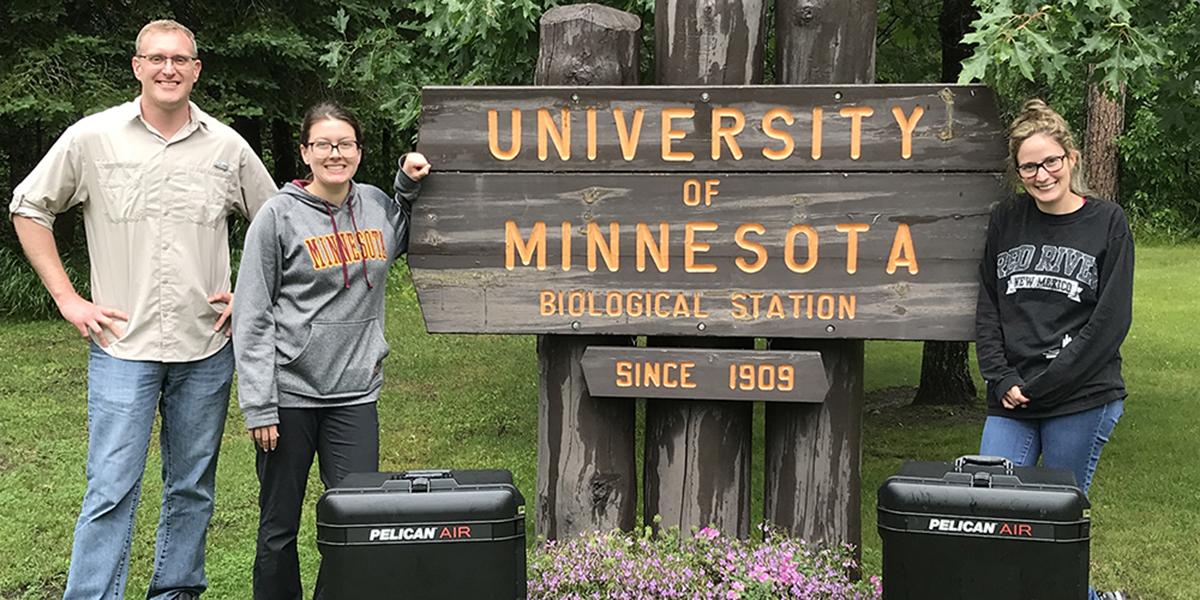Into the forest
A leading-edge mobile lab opens the door for discovery, education, and collaboration.

A leading-edge mobile lab opens the door for discovery, education, and collaboration.
Peter Larsen, Kenwyn Shriner, and Laramie Lindsey stand alongside the entirety of their mobile lab packed into suitcases.
One Health, the relationship between humans, domesticated animals, and wildlife, is complex and essential to the survival of all species on earth. Many diseases have adapted to spread across this web of animals and humans, infecting our food supply, wiping out endangered species, and shaking our ecosystem at its core. However, the lapse between sample collection and lab testing often results in scientists only being able to decipher where pathogens have been, not necessarily where they are going.
Armed with a novel mobile lab, researchers at the University of Minnesota College of Veterinary Medicine (CVM) are responding to this problem by implementing new methods that cut down the time between sample collection and lab testing. In July, the researchers tested their approach in Itasca State Park in Park Rapids, Minn. Then, in August, they brought their lab halfway around the world to Borneo, Malaysia.
On a hot July day, Peter Larsen, PhD, assistant professor in the Department of Veterinary and Biomedical Sciences, followed two researchers from his lab— Kenwyn Shriner, a second-year DVM/ MPH student and Summer Scholar, and Laramie Lindsey, PhD, a postdoctoral associate in the Larsen lab—through the deep woods of Itasca State Park. The team is not only testing for Borrelia, the bacteria responsible for Lyme disease, but also redefining the approach to doing so by performing genetic sequencing on the pathogen to better understand how it moves, evolves, and functions.
At the crux of Shriner’s project is an effort to refine and streamline the process of testing material for pathogens such as Borrelia. Previous to Shriner’s expertise and Larsen’s high-end technology, the process for performing a similar test on ticks in a traditional lab would have taken at least three days, not to mention the time to ship samples and wait in a lab’s queue for the test to be performed. Now, the mobile lab gets DNA sequencing results from individual ticks less than 12 hours from collection.
Shriner and Lindsey tucked their pants into their socks, zipped up their painter’s suits, and fashioned drag cloths to pull through the woods of Itasca State Park to collect ticks. In three hours, they collected roughly 50 of the bloodsuckers. After collection, the team assembled their mobile lab in the University of Minnesota’s nearby field station, setting out miniaturized technology and plugging it into a single power strip. The entire lab fits into just two medium-sized suitcases.
“Everything you see here can run on battery packs, too,” says Larsen. The effort in Itasca “ground truthed” the efficacy of his team’s approach before they traveled to the University of Malaysia, Sarawak (UNIMAS) in Borneo, Malaysia. There, the team established an international partnership around the mobile lab.
“The region we went to is in some of the oldest rainforest in the world,” says Shriner. “It’s an area where there is a lot of ecological diversity that is unexplored because the infrastructure of gathering samples in the rainforest, keeping them cool, and transferring them back to a traditional lab is too high of a barrier. Now, we can access so much by bringing the lab into the rainforest.”
Collaborating with UNIMAS gave Lindsey and Shriner the chance to confirm their own learning by training Malaysian graduate students on the mobile lab. Larsen’s team also provided UNIMAS with the tools needed to assemble their own mobile lab.
“In the coming months, UNIMAS students will take what they learned in the workshop and apply it to projects at their home institution,” Larsen says. “We will engage them monthly to discuss protocols and troubleshoot problems.” Next summer, the UNIMAS and CVM researchers are planning an intensive three-week expedition, which will investigate emerging foodborne pathogens in the area.
“The success of this year’s expedition means that there will be a day when multiple labs like this could be deployed around the state and around the world,” says Larsen. “This will change the landscape of bio surveillance, species discovery, molecular epidemiology—a wide variety of scientific endeavors.”
According to Larsen, the U of MN is one of the first in the United States to use this technology in this specific way. “We have shown proof of concept within Minnesota that this lab can be used for molecular diagnostics and that it can successfully be deployed in one of the most remote locations on the planet,” Larsen says. “It opens up so many avenues for discovery in molecular-based research anywhere on Earth.”
The approach the Larsen lab is refining can breed cross-cultural collaboration and be applied to Lyme disease, Ebola, African swine fever, foodborne diseases, or any other emerging threats—helping create a network of scientists equipped to respond to global game changers as they evolve.